

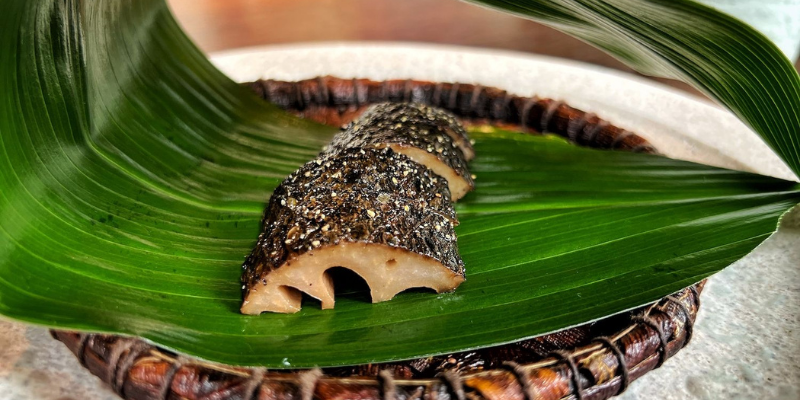
On October 18, 2022, Noma, the famed restaurant that introduced new Nordic cuisine to the world and put Copenhagen on the global food map, announced that it would have a 10-week pop-up in Kyoto, Japan, from March-May 2023.
In January 2023, it was announced that Noma as we know it would cease to exist at the end of 2024. Redzepi cited the unsustainable model of running a fine dining restaurant as reason to move towards the more creative and consumer-friendly food lab. This move left the world pondering the future of fine dining.
The gastronomic journey begins
On the week eight of the Kyoto pop-up, Noma’s interpretation of a kaiseki meal, the first five of the 17 dishes came in the form of the hassun course, a selection of small dishes reflecting what’s in season on that very day from the sea, the lowlands, and the mountain. Let’s discover some of the most delicious, mouth-watering plates from the pop-up event!
Hassun
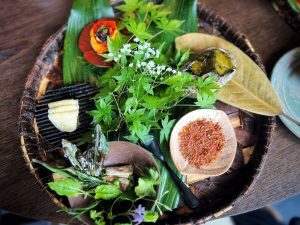
Hassun course (Photo: Aja Ng)
Silky yuba with bitter wild greens, grilled ramps, wild garlic shoots, intense dehydrated tomato in nasturtium flower, black garlic brushed cherry leaf, pollen and tomato gel, fermented barley cake with myoga ginger, and spring peas; paired with Our Rice Field saké by Hidehiko Matsumoto.
Seaweed Shabu-Shabu
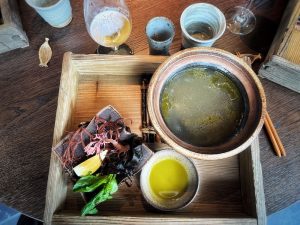
Seaweed shabu-shabu (Photo: Aja Ng)
Bubbling and steaming on the table in an earthenware pot without any heat element applied; broth came with a variety of delights to dip—fresh kombu and seaweeds, spinach with roots attached, konatsu citrus with edible rind, and a ponzu sauce. Swished in the hot dashi, the seaweeds changed colour and texture. At the bottom of the pot were rocks, probably the heating element that enabled the broth to still bubble at the table, but also a nod to kaiseki cuisine, where the kanji characters were stone and stomach. When Buddhist monks would fast in the days of yore, they placed hot stones on their stomachs or in their breast pockets to help alleviate hunger pangs.
With the shabu-shabu, a fruity saison with dashi and sansho, made lightly fragrant with bergamot, was served.
Bamboo Shoots
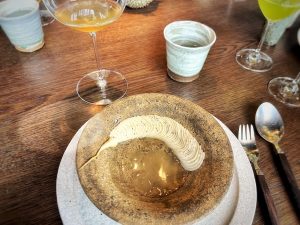
Bamboo shoots in a corn, squid and Japanese tea broth (Photo: Aja Ng)
Crisp-tender, thinly sliced bamboo shoots in a clear corn, squid, and Japanese tea broth; paired with the natural 2019 Let it Be Chardonnay from Beau Paysage.
Swordfish Belly Sashimi on Kombu Butter Sauce
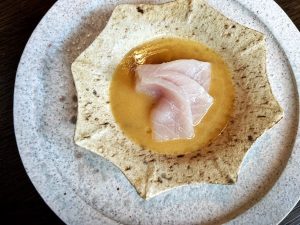
Swordfish belly sashimi on kombu butter sauce (Photo: Aja Ng)
You see three succulent slices of savoury swordfish belly sashimi on kombu butter sauce above, looking smooth and silky.
Fresh Tofu, Shaved Almonds, Nasturtium Flowers, Pine Leaves and Dashi
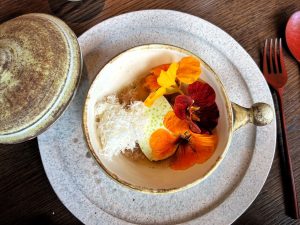
Fresh tofu, shaved almonds, nasturtium flowers, pine leaves, and dashi (Photo: Aja Ng)
The fresh tofu, shaved almonds, nasturtium flowers, pine leaves, and dashi looked quite beautiful, with pristine flavours, gossamer on the palate. With it, the cloudy 2023 Starburst nigori saké from Kumezakura brewery in the Tottori prefecture was served.
Fillet of Kinki
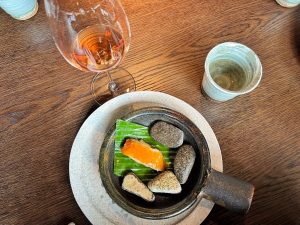
Fillet of kinki (Photo: Aja Ng)
The following fillet of kinki was cooked to perfection, first cured in elderflower miso, cooked skin-side down, then brushed with egg yolk and sakura blossom sauce. It was highlighted further by the Atsuo Yamanaka’s 2021 Hokkaido pinot gris, a skin-contact amber wine with sass, standing up to the meatiness of the fish and rich sauce.
Sansai
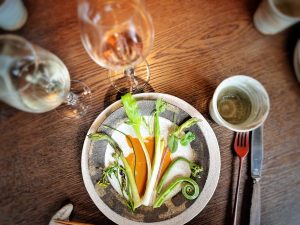
Sansai (Photo: Aja Ng)
Sansai, or wild spring mountain vegetables, foraged fresh just hours before, arrived next. Sitting on a sauce made from the tomalley of ise ebi (Japanese spiny lobster), the vegetables are each prepared in a different style: blanched, charred, and pickled.
On the palate they burst with flavours, some fresh and sweet, others intensely green and bitter, countered by the tomalley sauce. The 2023 Mori No Uta saké, a clear, bright, dry collaboration between Noma and renowned saké master Masaru Terada from Chiba, cuts through the potency of the tomalley sauce perfectly.
Lotus Root
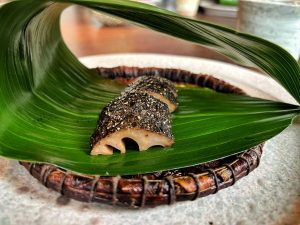
Lotus root (Photo: Aja Ng)
Then came the lotus root. The tuber was confit in koji oil overnight, then slow-barbecued for hours, glazed with a slew of garums and ferments. It was smoky-sweet, with flavours of mushroom and truffle, somehow still retaining some of that lotus root bite.
There was a hollandaise made with lots of butter and shijimi clam jus, with hints of seaweed and pine on the side.
Tail of Ise Ebi
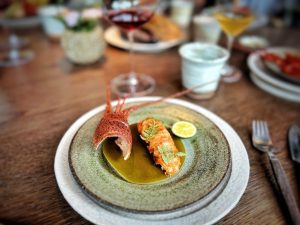
Tail of ise ebi (Photo: Aja Ng)
The next pour was the 2020 Kaze pinot noir, by Bruce and Ryoko Gutlove in Hokkaido. There was a bit of gamay in the wine, adding complexity and minerality. With it, came the succulent tail of the ise ebi, sitting on a corn and pumpkin paste, topped with sansho pepper leaves.
The corn and pumpkin have been treated in the same way as katsuobushi (the savoury skipjack tuna flakes which add to flavour many Japanese dishes), having been smoked, simmered, and fermented.
Midori Maya Green Rice
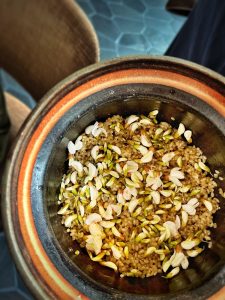
Midori Maya green rice (Photo: Aja Ng)
In a large earthenware pot, came the Midori Maya green rice, cooked with the remaining ise ebi and green tea before being strewn with acacia flowers and drizzled with Noma’s own rose vinegar.
Yuzu Shijimi Clams
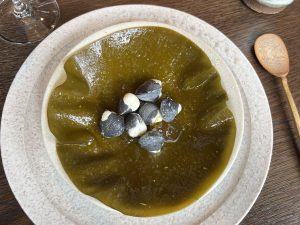
Yuzu shijimi clams (Photo: Aja Ng)
The yuzu shijimi clams ended the meal. Yuzu sorbet in frozen cream shells, on a barrel-aged sake gelee made a light, sweet impression. The dried strawberry and mochi packed a tangy punch, while the eggfuit offered a creamier conclusion. The final tipple in the series of eight was a fresh Fukushima umeshu, a light, nectar-tinged closing to the feast.
Dried Strawberry and Mochi
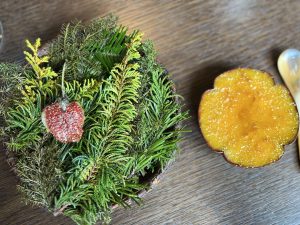
Dried strawberry and mochi (Photo: Aja Ng)